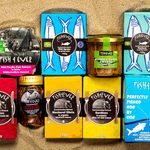You have no items in your shopping cart.
The oceans cover more than 70% of our planet's surface, providing a vast ecosystem of life that is vital to our existence. Among the diverse species inhabiting the oceans, tuna holds a special place as a prized catch for both commercial and recreational fishermen. However, the method by which we catch tuna can have significant implications for the health of our oceans and marine life. In this blog post, we'll explore why pole and line fishing for tuna is a more environmentally sustainable option compared to industrial fishing.
Industrial Fishing and its Consequences
Industrial fishing, also known as commercial or large-scale fishing, involves the use of massive nets, longlines, and other high-capacity fishing equipment to catch large quantities of fish, including tuna. While this method is efficient in terms of catching a high volume of fish, it has several negative environmental impacts.
-
Overfishing: Industrial fishing often targets specific species of tuna, without proper regard for their population size. This has led to overfishing and depletion of tuna populations in some regions, threatening the species' survival.
-
Bycatch: Large-scale fishing operations often result in substantial bycatch, which is the unintended capture of non-target species. Bycatch can include turtles, sharks, dolphins, and other marine animals, many of which are endangered or at risk.
-
Habitat Destruction: The use of bottom trawling and other destructive fishing methods damages sensitive marine habitats, such as coral reefs and seafloor ecosystems. This destruction can have long-lasting and far-reaching consequences for marine biodiversity.
-
Fuel Consumption: Industrial fishing vessels are typically large and require substantial fuel consumption, contributing to greenhouse gas emissions and pollution of the marine environment.
The Benefits of Pole and Line Fishing
Pole and line fishing offers a more sustainable alternative to industrial fishing, particularly for tuna species. Here's why:
-
Targeted and Selective: Pole and line fishing is a highly selective method that allows fishermen to target specific tuna species while minimizing bycatch. This reduces the impact on non-target marine life, including endangered species.
-
Low Environmental Impact: Unlike industrial trawlers, pole and line fishing vessels are smaller and have a lower carbon footprint. They consume less fuel, which translates to reduced greenhouse gas emissions and less pollution.
-
Minimal Habitat Damage: This method does not involve destructive practices like bottom trawling, preserving important marine habitats and minimizing damage to the ocean floor.
-
Sustainable Practices: Pole and line fishing operations often adhere to sustainable fishing practices, including catch limits and seasonal closures, to ensure the long-term health of tuna populations.
-
Support for Local Economies: Many pole and line fisheries are smaller-scale, local operations that support coastal communities by providing employment and economic opportunities.
Conclusion
As consumers, we have a role to play in promoting sustainable fishing practices. Choosing tuna products that come from pole and line fishing operations can help reduce the negative environmental impacts associated with industrial fishing. By supporting sustainable fisheries and advocating for responsible fishing practices, we can contribute to the preservation of our oceans and the well-being of the marine life that calls them home. It's time to cast a vote for the health of our seas and the future of tuna by embracing pole and line fishing as a more environmentally responsible choice.













